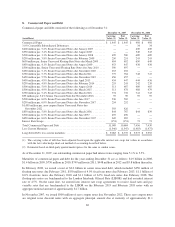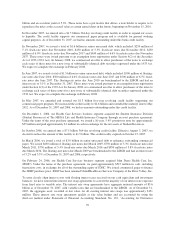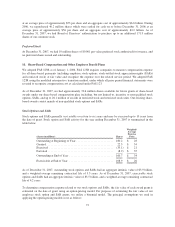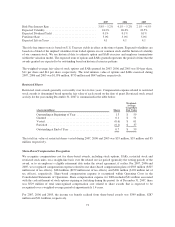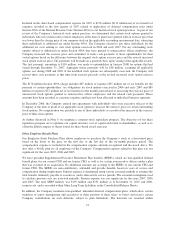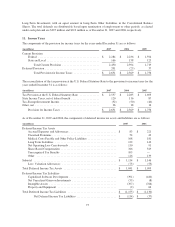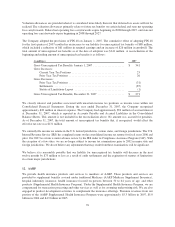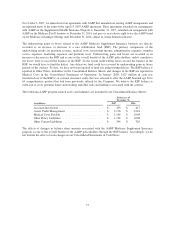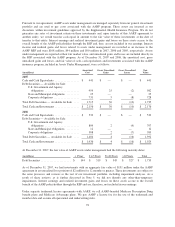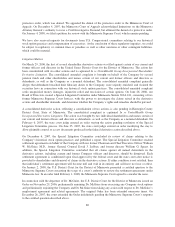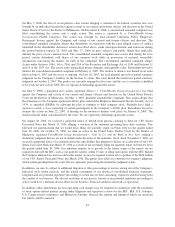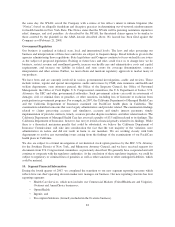United Healthcare 2007 Annual Report Download - page 76
Download and view the complete annual report
Please find page 76 of the 2007 United Healthcare annual report below. You can navigate through the pages in the report by either clicking on the pages listed below, or by using the keyword search tool below to find specific information within the annual report.Included in the share-based compensation expense for 2007 is $176 million ($112 million net of tax benefit) of
expenses recorded in the first quarter of 2007 related to application of deferred compensation rules under
Section 409A of the Internal Revenue Code (Section 409A) to our historical stock option practices. As part of our
review of the Company’s historical stock option practices, we determined that certain stock options granted to
individuals who were nonexecutive officer employees at the time of grant were granted with an exercise price that
was lower than the closing price of our common stock on the applicable accounting measurement date, subjecting
these individuals to additional tax under Section 409A. The Company elected to pay these individuals for the
additional tax costs relating to such stock options exercised in 2006 and early 2007. For any outstanding stock
options subject to additional tax under Section 409A that were granted to nonexecutive officer employees, the
Company increased the exercise price and committed to make cash payments to these optionholders for their
vested options based on the difference between the original stock option exercise price and the revised increased
stock option exercise price. The payments will be made on a quarterly basis upon vesting of the applicable awards.
The first payment, amounting to $110 million, was made to optionholders in January 2008 for options that had
vested through December 31, 2007. Aggregate future payments will be $38 million, assuming all applicable
options vest during 2008 and 2009. If the modified stock options are subsequently exercised, the Company will
recover these cash payments at that time from exercise proceeds at the revised increased stock option exercise
prices.
The $176 million Section 409A charge includes $87 million of expense ($55 million net of tax benefit) for the
payment of certain optionholders’ tax obligations for stock options exercised in 2006 and early 2007 and $89
million of expense ($57 million net of tax benefit) for the modification related to increasing the exercise price of
unexercised stock options granted to nonexecutive officer employees and the related cash payments. These
amounts have been recorded as corporate expenses and have not been allocated to individual business segments.
In December 2006, the Company entered into agreements with individuals who were executive officers of the
Company at the time of grant of an applicable stock option to increase the exercise price of certain outstanding
stock options. No compensation was payable to any of those individuals as a result of the increase in the exercise
price of their stock options.
As further discussed in Note 9, we maintain a common stock repurchase program. The objectives of our share
repurchase program are to optimize our capital structure, cost of capital and return to shareholders, as well as to
offset the dilutive impact of shares issued for share-based award exercises.
Other Employee Benefit Plans
Our Employee Stock Purchase Plan allows employees to purchase the Company’s stock at a discounted price
based on the lower of the price on the first day or the last day of the six-month purchase period. The
compensation expense is included in the compensation expense amounts recognized and discussed above. We
also offer a 401(k) plan for all employees of the Company. Compensation expense related to this plan was not
significant for the years 2007, 2006 and 2005.
We have provided Supplemental Executive Retirement Plan benefits (SERPs), which are non-qualified defined
benefit plans, for our current CEO and our former CEO, as well as for certain nonexecutive officers under a plan
that was assumed in an acquisition. No additional amounts are accruing to the SERPs of our current CEO and
former CEO. The SERPs are non-contributory, unfunded and provide benefits based on years of service and
compensation during employment. Pension expense is determined using various actuarial methods to estimate the
total benefits ultimately payable to executives, and is allocated to service periods. The actuarial assumptions used
to calculate pension costs are reviewed annually. Pension expense was not significant for the years 2007, 2006
and 2005. The total SERP liability was $139 million and $131 million as of December 31, 2007 and 2006,
respectively, and is recorded within Other Long Term Liabilities in the Consolidated Balance Sheets.
In addition, the Company maintains non-qualified, unfunded deferred compensation plans, which allow certain
members of senior management and executives to defer portions of their salary or bonus and receive certain
Company contributions on such deferrals, subject to plan limitations. The deferrals are recorded within
74







